New glass lobby, restroom wings planned for Macon City Auditorium renovation
In June of 2020, Macon-Bibb County commissioners got their first look at preliminary plans for a $10 million upgrade of the nearly 100-year-old Macon City Auditorium.
The Macon City Auditorium will get a major facelift before its 100th birthday that coincides with the 2023 bicentennial of the city’s founding.
Macon-Bibb County SPLOST project manager Clay Murphey told commissioners Tuesday that about $10 million dollars remains for the renovation that was included in the tax referendum sanctioned by voters in 2016.
Plans include improving handicapped access and fire safety, building two new octagonal restroom wings, enlarging the lobby, enhancing guests’ experience and creating a modern venue for performers.
Already, more than a million dollars was spent to waterproof and renovate the basement and repair the roof, which includes what is billed as the largest copper dome in the world.
Little did county leaders realize that the historic structure has been used for target practice or became collateral damage from celebratory gunfire over the last century.
“We found 51 bullet holes in the copper dome,” Murphey told commissioners early this year as Skyline Construction Services, of Eatonton, was working on the roof.
Tuesday, the Atlanta-based Smallwood architectural designers presented their plans for the renovation now that the roof and basement have been repaired.
Smallwood’s James Van Duys said the firm has done extensive research, pored over the original architect’s drawings and attended multiple events to assess the building’s functionality heading into its second century.
“The building is beautiful and it has good bones, but people arriving have a hard time finding where to go… getting to their seats, restrooms,” Van Duys said.
Event patrons often wait outside in long lines as tickets are taken.
“Functions we came to, there were tons of people wandering around looking for where to go,” Smallwood’s Chuck Hull said.
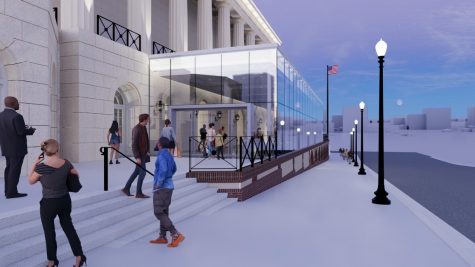
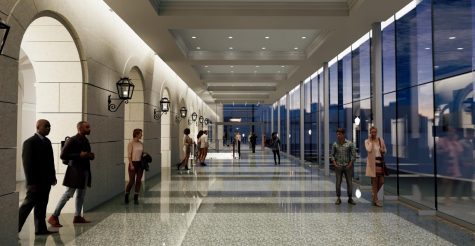
To solve those problems without obscuring the concrete and limestone original Roman architecture, they are proposing to extend the lobby with a glass vestibule that would stretch over the existing stairs along First Street.
Currently a 10-foot wide hallway serves as the lobby on the three sides surrounding the seating area. The 23-foot wide glass addition would stretch across eight of the ten columns along the front of the building.
The side terrace overlooking Cherry Street would be extended around to First Street to join the new lobby with its ultra-clear glass.
“It will be glass all the way around. You can see right through it,” Hull said. “It will be covered and conditioned so it’s comfortable. It will allow us to move ticket taking into the space to keep people out of the weather.”
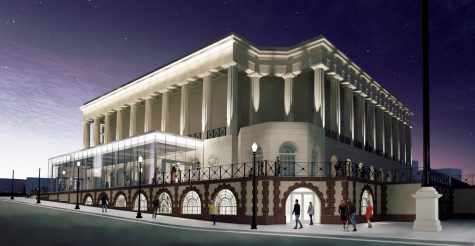
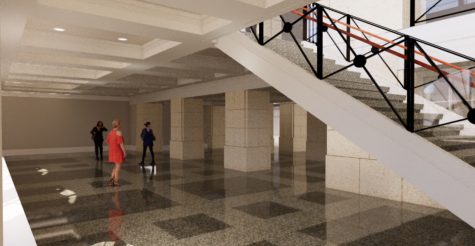

Stairs would be removed at the corner of First and Cherry streets and a new ground level entrance would be built for access to a new lower lobby leading to the space that currently houses concessions, bathrooms and meeting rooms.
Brick-framed, circle top windows that taper in size along the grade of First Street will allow natural light into the lower level while complimenting the original arched windows and doorways on the main level.
A new staircase, connecting to the upper lobby, and an elevator would be installed near the new handicapped accessible entrance at the corner.
“I’m most excited about the ground level entrance to the lower floor at Cherry Street,” Mayor Robert Reichert said.
Currently the only wheelchair access is through the south lobby facing Government Center. A service elevator currently exists off the alley next to Snow’s Memorial Chapel.
Mayor pro tem Al Tillman questioned why there is no handicapped access planned for the balcony level.
The colonnade on the upper level – the walkway between the columns and the building – complicates adding an elevator.
“Any place you’d bring an elevator would be going outside the building,” Van Duys said.
Tillman questioned whether a ramp could be installed, instead.
“A ramp of that size would need to be 10 feet wide,” Murphey responded. “You’d lose an entire hallway and if you did it outside, it wouldn’t fit with the architecture we’re trying to save.”
Contractors have to work within the footprint of the masonry building as every wall is functional, Murphey said.
Hull said: “That sort of intervention would damage the historical integrity. … If this was any old auditorium, I’d agree with you, but you have a historic building of some significance.”
The bathrooms currently on the ground floor would be scaled back to allow for a new pass-through to the lower level concessions lobby.
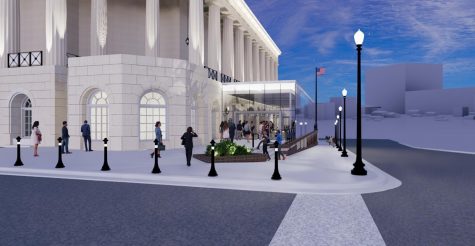
Flanking both corners facing First Street, octagonal additions for restrooms are planned for the main floor where only one small family bathroom and a larger bathroom off the stage currently exist.
A will-call area would be placed in the eight-sided wing closest to Rosa Parks Square. The designers also plan to square off that entrance to Cherry Street Lane where people can be dropped off at the curb. The incline on First Street is too steep for vans for the handicapped, Hull said.
The auditorium also needs a new fire alarm system and upgrades to the stage and lighting.
Smallwood suggests expanding the stage and putting in a lift to help with production equipment and in bringing up tables and chairs from the basement storage.
A new catwalk system will replace a circular platform at the ceiling that is difficult to work with, Van Duys said. A lowerable lighting truss would accommodate equipment for modern stage productions.
They plan to eliminate the control room in the balcony where they will install additional seating and a couple of platforms for spotlights. A new control booth would be built on the main level and the sound system will be upgraded to improve acoustics.
“Man this is awesome,” said Tillman, who runs a professional booking and talent agency.
Smallwood and the county will now hire a contractor for the project that is slated to be completed in time for the centennial of the building that made the National Register of Historic Places in 1971.
The last major renovation was about that same time so all the colors and décor will be updated with shades of blue and neutrals.
Last century, it cost just $500,000 to build the whole auditorium but renovating it will total 20 times that.
“There won’t be a part of that building untouched,” Murphey said.
Contact Senior Reporting Senior Fellow Liz Fabian at 478-957-2829 or fabian_lj@mercer.edu.









Alan Thiese • Jun 26, 2020 at 5:17 pm
“No part of the building will be untouched!” A quote. Unless I messed it in the article no plans on any restoration of the wonderful theater pipe organ are included in this renovation. Are there any plans for this restoration?
Liz Fabian • Jul 1, 2020 at 4:18 pm
As far as we know, there are no plans for that but we will ask.